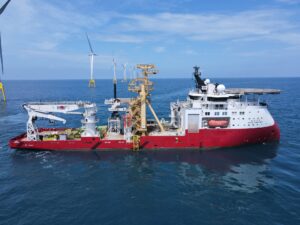Ulstein lays keel for newly named Nexans cable laying vessel
Norwegian shipbuilder and ship designer Ulstein Verft has held the keel laying ceremony for the DP3 cable laying vessel (CLV), Nexans Electra.

Keel laying signifies the start of assembling the key components for a newbuild vessel. The Nexans Electra, ordered as the second ship by Nexans at Ulstein Verft, is an updated version of the Nexans Aurora, delivered in 2021.
Featuring a two-carousel solution, the Nexans Electra will be equipped for power cable laying including bundle laying, cable jointing, repair, system protection, and trenching.
The cable laying vessel is equipped with features such as a split turntable on deck capable of holding up to 10,000T of cable, an under-deck turntable with a 3,500T cable capacity, and a fibre optic basket holding 450T.
Capable of laying up to four cables simultaneously, the vessel is designed to operate efficiently even in harsh weather conditions, thanks to its maneuverability and station-keeping capabilities, Ulstein said.
Nexans Electra has dimensions of 149.9 meters in length, 31 meters in beam, and a dead weight of 17,000T. It has a capacity for up to 90 people.
The name, Nexans Electra, was selected through an internal naming contest at Nexans, in line with the company’s slogan, ‘Electrifying the future’.
“We are excited to see the first major milestone of the construction of the Electra underway and look forward to seeing the ship completed in its entirety,” said Marco Bregman, Director of Installation and Services at Nexans.
Related Article
Hull construction is progressing in Crist, Poland, while the remaining processes such as engineering, outfitting, system integration, equipment preparations, testing, sea trials, and finalization will take place at Ulstein Verft in Norway. The ST-297 design has been developed by Skipsteknisk, a Norwegian ship design and engineering company based in Ålesund.
“In the upcoming months, the project management will prioritize several key areas,” said Runar Toftesund, project manager at Ulstein Verft.
“First, there will be a continued focus on hull construction, ensuring the structural integrity and foundation of the vessel. The hot work outfitting and paintwork will be carried out in Crist. Parallel to this process, collaboration with Nexans and other main suppliers will remain crucial to sustain the project’s momentum and drive progress.”









